Entries Tagged 'Magic' ↓
July 16th, 2013 — Games, Magic, What's Wrong With...
I decided to invent a new blog category called “What’s Wrong With…” (WWW) which will examine cards that are almost there but for one (or so) fatal flaw(s). I mean it isn’t so hard to identify a card like Kalonian Hydra and be like “Yo, Kalonian Hydra is a big giant monster — RAH!” or Young Pyromancer and be like “Yo, I have a feeling mages might be summoning a Young Pyromancer in beatdown decks, burn decks, and even blue decks” but what is more interesting are the cards that you really want to play… But won’t.
You know the cards?
Feudkiller’s Verdict and so on? I was at one point sure Feudkiller’s Verdict was going to be the bee’s knees. It was more like Andrew Bynum Greg Oden’s knees.
The reason I think this kind of exploration can be interesting is that from a critical thinking standpoint it can force us to think about a little bit of a different universe, a tweak here, a pull there, to try to figure out what would have to be different for a card to see lots of (or any) play.
Today’s victim is Seraph of the Sword.
I had actually been meaning to write about Seraph of the Sword since my first perusal of M14 for last week’s Flores Friday (which ended up being about the aforementioned Kalonian Hydra and Young Pyromancer, primarily).
But it turns out that Seraph of the Sword was also yesterday’s Card of the Day at ye olde Mother Ship DailyMTG.com.
At first I was pretty excited about Seraph of the Sword. I mean It looked like the 3W cousin of Dawn Elemental.
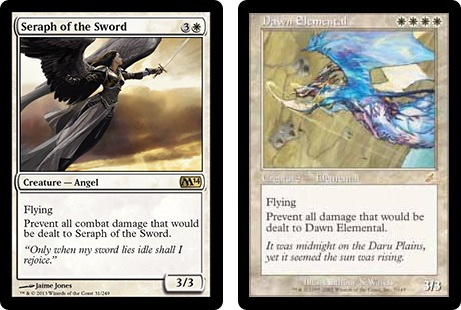
Seraph of the Sword and Dawn Elemental
Dawn Elemental was a pretty exciting Onslaught Block card… The best Phantom Monster there ever was. For Limited a 2/2 flyer for white is pretty standard for 3W (four mana) but Dawn Elemental gave us a 3/3 with a hell of an ability for four mana. Now of course WWWW is quite a few mana symbols off of 3W, but on the other hand the trade-off was substantial. Dawn Elemental would brook no Silver Knight. It would gobble up any and all Elvish Warriors. Sorry, Goblin Piledriver (or almost any other Goblin). Y’all dead.
Of course it took a particular kind of deck to play with Dawn Elemental due to the prohibitive number of white mana symbols in the upper-right corner. So it was primarily played in MWC. That said, it didn’t take long for such a Mono-White Control deck to make a splash on the second-biggest stage:
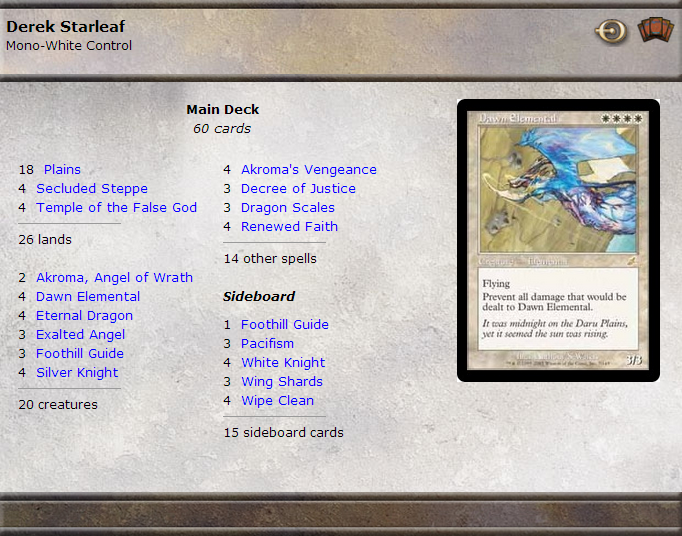
Derek Starleaf and his Dawn Elementals fought their way into one of the most stacked Top 8s in Grand Prix history. You couldn’t swing a drunken Tyrion Lannister in that Top 8 without hitting US National Champion Eugene Harvey; or notable Pros Morgan Douglass or Alex Shvartsman; or four-time Pro Tour Top 8 competitor (and Pro Tour Champion) (and THE PRICE IS RIGHT superstar) Mark Herberholz; or Hall of Famer / Dark Confidant / Superman Bob Maher; or beloved former Number One Apprentice Joshua P. Ravitz.
Stacked.
Starleaf didn’t win that Grand Prix, but he did a great job showcasing the angles on and impact of Dawn Elemental. Despite playing four main-deck copies of Temple of the False God, Starleaf put his faith in the WWWW Dawn Elemental, which was an undersized-but-effective carrier of Dragon Scales. Dawn Elemental might not have triggered the re-buy on Dragon Scales, but it wasn’t inviting a one-for-two either, being so hard to kill with damage.
So… Seraph of the Sword is Dawn Elemental 2K13, right? Right? Sadly, no.
So…
What’s Wrong with Seraph of the Sword?
One Word.

“combat”
Argh!
Combat!
As you can probably guess, as soon as I read that one word (which, by the way, took a couple of reads) I realized that Seraph of the Sword is close to unplayable in Standard, at least main deck. This is going to eat a Searing Spear, Mizzium Mortars, or Warleader’s Helix too often to justify the mana. Remember: Per Mowshowitz, four mana is the threshold where a card has to be able to win the game for you by itself… And Seraph of the Sword, on average… I don’t think it is going to get there.
That said, I think there might be some angle on this card, perhaps out of the sideboard. If you are playing against a deck — probably a creature deck — that doesn’t play damage based removal (or any removal, even better), Seraph of the Sword can be a heck of a stop sign that also gives you a way to win. Unlikely, but probably not impossible.
Oh, go buy some OMGs!

LOVE
MIKE
July 7th, 2013 — Games, Magic
Last week I was perusing the M14 Card Image Gallery over at the Mother Ship and happened upon this spicy three drop:
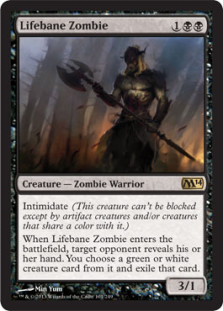
Lifebane Zombie
What did you think when you first saw Lifebane Zombie? Pretty good hoser card? Playable main deck! (if barely) The power-to-casting cost isn’t too far off; the built-in evasion packes a little extra value into Lifebane Zombie as a combat creature, at least against non-black; and when you are up against green and / or white it is actually a potential murderer. Is that what you thought?
Me?
I thought about my man Slithery Stalker:

Slithery Stalker
Slithery Stalker saw relatively little play outside of Odyssey Block Constructed, but it was a main deck 187 in the Block Pirates! deck. Pirates! wanted any potential self-contained card advantage that could be packed into a body, and Slithery Stalker fit the bill, especially given the popularity of U/G (and to a lesser extent G/W) creature decks in the format.
So… Why bring it up? How does shiny new Lifebane Zombie remind us of that rusty old 1/1?
Slithery Stalker featured prominently in my second Star City column, Realizing How Bad You Are, which was at that point maybe the most controversial strategy column ever:
I was playing in the last qualifier (not counting the Last Chance Qualifier) for last year’s PT Houston. The format was Odyssey Block Constructed, and, not surprisingly, I was running a U/G Threshold developed with Brian David-Marshall. I didn’t like having to play in this PTQ at all because I was technically qualified on rating, except that there was a reporting mistake on the K value of a tournament I had won earlier in the summer, meaning that I needed some small number of points in order to make the ratings qualification cutoff. But I wanted to be qualified, so there I was gaming in the PTQ.
U/G was not actually my first choice. I really liked the mono-black Pirates! deck, but due to horrible things on Day Two of the Pro Tour, Stalking Tiger, Hidden Gibbons somehow dropped from their first place position to a nowhere land of non-qualification, meaning that Paul Jordan, the owner of my planned Pirates! deck, would be making Top 8 with it himself, and I was stuck with my previous week’s weapon of choice.
So with Pirates! on my mind, there I was, three rounds deep.
My third round opponent won the Game One roll and played first. On his turn, he played Swamp.
On my first turn, I played Island (I had Mental Note in hand), and passed the turn back.
My opponent followed up with another Swamp, and played Mesmeric Fiend. With the following hand, I chose to let the Fiend resolve:
Aquamoeba
Aquamoeba
Breakthrough
Mental Note
Werebear
Forest
Island
I could have played Mental Note in response, but I didn’t think that would be a particularly good play. My opponent may have taken the Mental Note rather than one of the potentially more relevant cards, or I could have randomly put a more juicy card into my hand (say, Phantom Centaur), that I would rather not have hiding under my opponent’s Fiend.
To my thinking, Swamp, Swamp, Mesmeric Fiend could represent for the opponent one of three known deck archetypes: a B/u Braids/tempo deck, the mono-Black Pirates! deck, or a hybridized mono-Black control/Pirates! blend. The obvious choice would be for the opponent to take Werebear (my best enabler), and the other possible choice would be to take Breakthrough (card advantage, and synergistic with Aquamoeba, Werebear, and Wild Mongrel all).
So you can imagine my surprise when the opponent instead chose Aquamoeba.
Why would he do that? I even had another Aquamoeba!
I decided that he wanted me to play Werebear. The only reason he would want me to play Werebear, potentially a 4/4 attacker in short order given the Blue cards in my hand, as well as a powerful mana accelerator, would be because he had an answer in his hand that could tackle Werebear, but would not be good against Aquamoeba.
That smelled like Slithery Stalker to me.
So on my second turn (after a Mental Note at the end of his turn, of course), I decided to say”Screw you, opponent,” and play Forest, Aquamoeba.
My opponent untapped, tapped three lands, and…
Sent my Forest to the graveyard with Rancid Earth.
I untapped, played an Island (putting me back to two lands) and sent Aquamoeba for three. Luckily for me, somewhere between my Mental Note and the ensuing draws, I had plucked Basking Rootwalla and Wonder. Obviously I used Wonder for the Aquamoeba pump.
Down to seventeen.
On his turn, my opponent decided to respond to my aggression by counterstriking with his Mesmeric Fiend. The Basking Rootwalla jumped out of my hand and met his Mesmeric Fiend. I would have preferred to pump and save it, but alas, that was impossible with UU open. Nevertheless, I was able to recover my Aquamoeba.
Unfortunately for me, the opponent followed up his attack with one of the worst possible cards for me at this point: Braids, Cabal Minion.
I untapped and lost one of my Islands. I ripped a land, but unfortunately it was yet another Island, rather than the Forest that would have allowed me to play Werebear. With Wonder in the ‘yard, I sent Aquamoeba for another three and played the other Aquamoeba, leaving me with two Islands and two Aquamoebas in play.
Got him to fourteen.
My opponent did something, but it didn’t involve killing an Aquamoeba or an Island, so on my turn, I lost an Island, and then tossed two cards from my hand to put my opponent to 8.
On my sixth turn, I had a really tough decision. I was down to just an Island and my Aquamoebas. I could either lose an Aquamoeba and send the other with Wonder, or I could lose my Island. If I didn’t draw land (specifically Island), I would end up losing Wonder potential next turn even if I saved the Island this turn, and if I kept both Aquamoebas, my opponent would have to block with Braids or take six, meaning that I could win the game the next turn any number of different ways.
So I made a hard choice and lost the Island. Of course I didn’t draw a land.
I send the Aquamoebas. Both had cards pitched to them. One put my opponent to five, and the other traded yet another card to get rid of Braids. If I had been able to save it, I would, but out of cards, I was at least able to get that dangerous permanent off the board.
As it happens, my opponent didn’t draw anything to block an Aquamoeba or any of the zillions of ways he must have had in his deck to kill a creature in time, and my little Blue Beast did him in, winning me the game with no cards in hand and no non-Aquamoeba cards in play.
He revealed his top card, which was, of course, Chainer’s Edict.
That was some good Magic. I won the game with no cards in hand and no non-Aquamoeba permanents in play, while my opponent had both cards in hand and lots of lands. In fact, if I had played any less precisely, sacrificed a man instead of an Island, been less all-in with my attacking, I would almost certainly have ended up on the wrong end of that Chainer’s Edict. I played so fast and hard that I denied my opponent the opportunity to draw his out. This was probably the best game of Magic I had ever played.
I liked this game so much that I immediately told my friends the Pro Tour Champions.
“And to think, you used to be good at telling stories.” – Bob Maher
I of course didn’t understand why Bob was shaking his head. This was the best game I had ever played! I had my back against the wall the entire time. I had no cards in hand and only an Aquamoeba when my opponent lost. I never broke out of Braids lock, but I never gave up, either.
Dave Price pointed out something very obvious (which was why Bob was so disappointed). Even assuming my opponent had the Slithery Stalker (which he didn’t), and it was right to hold the Werebear on the second turn (which it wasn’t), I should have played the first Aquamoeba with double Island.
Imagine how different that game would have been if I had just held the Forest. I would not have lost it on the third turn to his Rancid Earth. When I played the Basking Rootwalla to get back my second Aquamoeba, I would have been able to pump it rather than just trading with the Mesmeric Fiend. Turns later (especially given the fact that he didn’t have the Slithery Stalker) I would have been able to play a sizable Werebear, rather than just tossing it to Aquamoeba for an ephemeral two damage.
It might be reasonable to say that I played really good Magic from turn 3 forward, that I played out of one or more mistakes made in the first turns, but the fact of the matter is that I was a little lucky, just lucky enough, and at the right moments, to counteract all the horrible luck I had that game. This wasn’t the beautiful game of Magic that I thought it was, and the fact that I thought that I played so well punctuates the idea that players who win tend not to see their own mistakes, however horrible.
The next time your lucksack opponent top-decks the one crappy card that he needs to in order to win the game on the last turn, you know, the turn that you were about to win, deserved to win, but ultimately didn’t, damn that lucky lucksack top-decker, think for a moment. You might have made a crucial error in the first couple of turns of the game whereby your opponent was gifted with the two life that postponed the end of the game by a turn or more. You may have given him the opportunity to stabilize the board, make a crucial chump-block, or top-deck the card that beat you when the opponent should never have had the chance.
Just the idea of Slithery Stalker was enough to send me into a tailspin of playing-the-wrong-land followed by narrowly considered, arguably perfect, execution (given a sub-optimal start). Lifebane Zombie is approximately three times as powerful as Slithery Stalker… It has three times the power; its evasion is effective something like four times as often (non-black versus black); it’s anti-Selesnya card advantage, though hitting the hand and not the battlefield, doesn’t come undone when it dies.
Then again, if I had [incorrectly] guessed Lifebane Zombie, I would have just played the Werebear and avoided much of that situation’s stress.
Nevertheless, pretty substantial creep without actually hitting the level of a Perish for three mana.
But even further than the power creep on three drop anti-Selesnya creatures is the strategic leap players have made. Like I said, Realizing How Bad You Are was pretty controversial in 2003. Jon had been talking about there being only one right play in smaller circles, but it was not a commonly held tenet by the majority of the Magic universe yet. Today, most players understand the difference between optimal play and everything else; only by striving to make the best plays can we give ourselves the best chances for victory. In 2003 players were more broad minded about plays in a philosophical sense, aligning themselves more with what seemed to feel right at the time without considering the structure of repeated actions and the production of predictable results over time.
Count yourself lucky that you know better.
LOVE
MIKE
July 7th, 2013 — Games, Magic
This post is inspired by the Guerilla Tactics I found digging around my parents’ basement last week; you may have read about this expedition here.
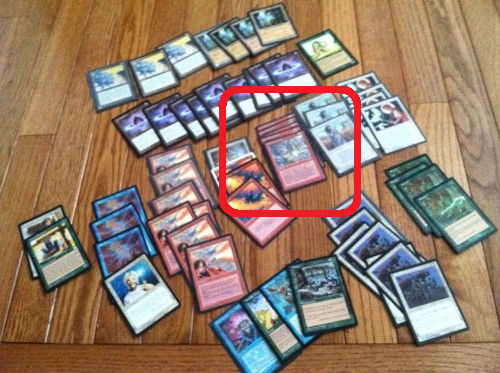
Among other things, Guerilla Tactics.
And in case you were wondering, I sadly found only four regular Gaea’s Cradles upon returning to New York 🙁
Guerrilla Tactics returned to the playable conversation when Patrick Sullivan publicly bought a playset from Star City Games prior to Grand Prix Denver. He got to showcase them against the many Liliana of the Veil decks in matches like his successful feature against Former #1 Apprentice (and GP Denver Top 8 competitor) Joshua P. Ravitz.
This tale of Guerilla Tactics is a story, a lesson really, from my first Pro Tour. You may have read here, here, or elsewhere that I won an Ice Age/Alliances PTQ with a B/R Necropotence deck. In college in Philadelphia I had a great group of friends with whom I played as many as fifty hours of Magic with per week. We played draft, Standard, PTQ formats, and ground dozens of matches of Arena League. We played local Philadelphia tournaments together (though I was the only serious-serious one) and adventured to reasonably close PTQs within ~2 states, usually via public transportation. The most talented player in our group as Albert Tran (the only player other than myself to win multiple Blue Envelopes when we were in college) but unlike most of the rest of us, altran was wasting his college years on a string of cute Asian girls so was very off and on in terms of how seriously he took Magic at any given time. Ergo the effective best player in the group was, unfortunately, YT.
Being the best player in your community is mostly terrible. You play for more hours than most people have jobs, and consistently win no matter how badly you execute. If your only goal is to be king of the kitchen table this can make you the local Alpha Nerd; if you actually want to become a World Class Magic player you have little opportunity to tear up bad habits and build up myelin. When I was competing hard with The ‘Pile o’ Bitches the next year — my first standout deck design and when I first got serious about writing tournament reports — we were concurrently grinding Mirage/Visions Constructed in the store Arena League. The best deck at the Mirage/Visions Pro Tour was the proto-Storm Combo deck Prosperous Bloom; I was dominating our local league with my Teremko Griffin deck:
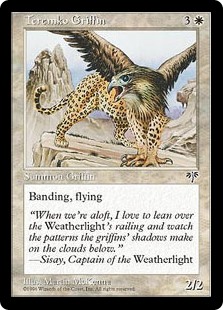
Like you, my 1997 opponents didn’t understand how Banding works.
Not only was a turn three combo deck available, Nekrataal was probably the most played creature… and, again, I won the Arena season with 2/2 Banding Weapon of Choice 🙁
Nevertheless, I was lucky enough to have contacts in a wider world. Worth Wollpert came down to Philadelphia from Penn State to test for the Pro Tour with me; Worth was training up to become a member of Team Deadguy after impressing Chris Pikula et al in the East Coast cash tournament series of that era with his “Demonic Consultation for Channel” gambles to set up the lethal Fireball.
I am sure that to Chris — who, among his immeasurable contributions to the game even then was a Top 8 coverage commentator and one of the faces on ESPN — I was at best a barnacle wannabe hanger-on at the time, but luckily Worth took care of me like his annoying kid brother. We came up from the same store in Ohio, and helped each other Q early on. As such, I got to play essentially the same Necropotence deck as Chris (Top 4) and Worth (Top 16) at Pro Tour V (139th if memory serves).
Our conception of sideboarding strategy was not then what it is now. Of the three of us, Chris was the only one to have Anarchy for Circle of Protection: Black, Circle of Protection: Red, or Karma (Matt Place destroyed me with the Place/Weissman U/W Control deck); Worth and I played a single Final Fortune; and of the three of us, only I had Demonic Consultation (tested with Erik Lauer the night before).
What sucks when you hit your second-turn Hymn to Tourach?
Guerilla Tactics!
So I am up in the Necropotence mirror in maybe my first ever match as a Pro; my opponent hits a fast Hypnotic Specter. I look at my hand gleefully… My sided-in Guerilla Tactics!
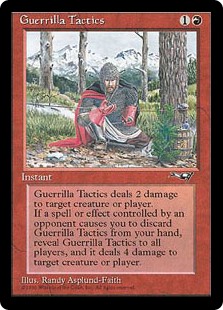
Cool things were dangerous even then.
Now I can make a pretty clean play on my turn: Just play my land and Guerilla Tactics the Hypnotic Specter, right?
However by drawing my sideboard card in the proscribed spot (against my opponent’s discard mechanism) I found myself in a serious The Danger of Cool Things moment. Do you see it? You probably don’t, thank God.
I am probably one of the top 100 players in the world at this point and this is what is going through my head:
If I let him hit me with that Hypnotic Specter, I might [randomly] discard it and hit the Specter for 4.
Can you even imagine fathoming this in 2013?
This was the first few turns of the game; There wasn’t even a positive likelihood he was going to randomly hit the Guerilla Tactics! Still, I passed.
Worse: I didn’t even make a turn two play! I mean it would be one thing if I stuck a Black Knight or something and lucked into the Tactics while tapped, right? Nope.
It wasn’t over. Maybe he was going to draw Hymn to Tourach or Stupor me prior to attacks. Maybe I would get to discard Guerilla Tactics and punish him as a freebie! Now that would be both cool and validating! Nope.
It still wasn’t over! I could have thrown banana peels at his Specter* prior to damage and saved myself two points. Still… Still nope.
This is what happened:
He attacks.
I discard [not Guerilla Tactics] — literally throw a card into the garbage can and give up two points.
He does something and / or passes.
I Guerilla Tactics the Hypnotic Specter.
Can you even imagine fathoming this in 2013?
So whenever I see a Guerilla Tactics; this is what I think about. Cool things; a game poorly played… And my first Pro Tour 🙂
But I can also see, in a world with a resurgent Guerilla Tactics, how far we’ve come. I think about myself, then such a strong player [relatively speaking]… with such a poor systematic understanding of the game; versus the baseline level that competitive players are all at today. The glory of this story is that few (if any) of you would have made the same kind of fumble, or even seen it as a possibility. Let’s list just a few of the reasons why:
- Classical v. Romantic approaches to common situations… Perfection versus subjective or personal criteria in evaluating a play.
- Appropriate pricing – How much does this effect cost? How much does this cost me? What is scarce here? Life / mana / cards / what? What do I actually need in this game?
- Tight play – What play will give me the best result, on average, if I do it each and every time?
- Philosophy of Fire – Would I ever give up a free Shock (let alone a Shock and a card) after 1999?
- Removal on your own turn / when your opponent’s mana is tapped – Because the last thing you want is to eat a Giant Growth
To sum it all up, the idea of springing a Guerilla Tactics on the attacking Hypnotic Specter was exciting. I was excited, emotionally, by drawing the card I wanted to see against my opponent’s aggressive discard deck. I saw the possibilities in the card, perhaps remembered being spanked by its anti-discard ability to smack for four in my own testing. Perhaps that excitement confused me for a moment… Did I really want to hit the Specter, or did I just want to hit the opponent, punish him for his arrogance, his devotion to The Skull? Likely I had this combination of excitement, the exhilaration of playing on my first Pro Tour, and the stress of playing against my opponent’s best hand all at once. Certainly I didn’t have the modern ideas of focus yet; nor had Jon delivered either of his two famous edicts (nor did he have the reputation yet, that anyone would listen).
A Hypnotic Specter is just a 2/2. We only need two damage to deal with it. If we don’t deal with it, it is going to generate a ton of card advantage for the opponent while whittling away at our life points. This is really super bad for us! There is a reason that first turn Hypnotic Specter is the scariest play in the format!
How did I forget that, myself?
It can be tough comparing Magic in 2013, with all the things you already know, and the vast canon of Patrick Chapin, Zvi Mowshowitz, and Frank Karsten that has come before to draw upon… And try to imagine a world almost 20 years ago, when USENET was the pinnacle of the strategic universe, perhaps THE DUELIST, which came out once per month. Succeeding back then was easier in the sense that the “haves” had a lot more than the “have-nots”… But in another sense, getting to be a “have” took a heck of a lot more work.
LOVE
MIKE
* Sorry, wrong kind of “gorilla” [guerilla]. Very pun-ny.
July 2nd, 2013 — Magic
Joseph Americ Pasco (@affinityforblue 140 characters at a time) is an innovator of Magic podcasting; enunciator emeritus of Yo! MTG Taps and current co-host of In Contention, the official podcast of the Star City Games Open Series. He is one of my favorite people I have met on Twitter.

Full Disclosure (and to be fair to Joey) if the Star City Invitational were tomorrow, I would play the U/R/W Aetherling deck he made.
I think the first time I clashed with my good friend Joey Pasco on the topic of his slavish adherence to Islands was around Grand Prix Washington D.C. 2010, a short time after I won a Nationals Qualifier with Grixis Hits. BDM had qualified in the same tournament with a Naya Vengevine deck designed by Gerry Thompson. I mean respeck. Respeck all around. I was a bit queasy about Grixis’s continued viability in the format due to the snowballing of Vengevine — so resilient against Grixis discard and removal strategies — down the metagame mountainside. Joey, on the other hand, said he wanted to Counter Target Spell. I was like, “Good luck countering a Vengevine.”
I didn’t — and don’t — have a huge problem with blue in general. At the time I just rejected the notion of the traditional blue control deck that draws cards at instant speed (with Jace’s Ingenuity) and Counters Target Spell. My idea at the time coming off of maxmially efficient single card choices a la Naya Lightsaber and Grixis Hits was that even when you were blue, you wanted to be active, not tapping three for Cancel, and in the wee hours of that Grand Prix D.C. Brad Nelson emerged triumphant with a U/W Control deck… sans main deck permission.
But dear Joey carries the handle @affinityforblue on Twitter (really has Affinity for Islands, but that doesn’t fit) for a reason; he is a blue mage through and through, a blue mage to his guts and a blue mage in his soul. It is okay to be a blue mage; Patrick Chapin is a blue mage to the extent that he loves Cancel more than Counterspell (anyone can love Counterspell… a real blue mage shows his colors by being willing to cast a Cancel)… I can understand Patrick’s forthrightness in tapping three mana to do two mana’s work even if I wouldn’t be happy doing the same thing, and absolutely tip my hat to his ability to trick Hall of Famer DIs like Gabriel Nassif into the same. My clashes with Joey come from a perceived inflexibility. Patrick will Suspend a Wheel of Fortune and deal you seven to pop a Hideaway if he has to; to my mind Joey doesn’t just lean blue but will go blue even when it isn’t good for him.
Argh! MichaelJ throws up his arms! Americ!
Joey, good natured, chuckles at a frustration he, himself, never feels.
Today I realized it isn’t Joey who has a problem; for…
THERE IS NO ZEALOT LIKE A CONVERT
Where is this coming from?
Joey Pasco is one of my favorite Magicians!
Just last month he let me bunk at his beautifully-kept Baltimore home!
So I am currently in Gates Mills, OH, visiting the ‘rents and gearing up for a week of the best roller coasters on earth, hot dogs, and fireworks in the burbs. Last time I was here, I made off with a hella haul, uncovering over a dozen Force of Wills and other booty combing through my old bedroom drawers.
Riding home from the aforementioned Baltimore trip, my friend Josh Ravitz and I did some trading; Josh saw a couple of Judge Foil Gaea’s Cradles in my binder and asked me how many regular Gaea’s Cradles I have. I dunno. Probably twenty. “They are like $150.” That was roughly the equivalent of that time Worth Wollpert and I were having steaks in Seattle and he told me that my Wastelands were all worth $60 [I really should have liquidated x-4 at $60]. Stupid Josh! I probably would have given him both of my foil Gaea’s Cradles for a set of Geist of Saint Traft (Judge Foil Gaea’s Cradles sell for between $300-$400).
So here I am back in Cleveland and I am digging like a truffle hound for all kinds of Gaea’s Cradles. I have no idea what I have left here versus what I [correctly?] brought to New York when I moved in 1999. I mean last time I dug, I found over a dozen Force of Wills!
This ended up today’s haul:
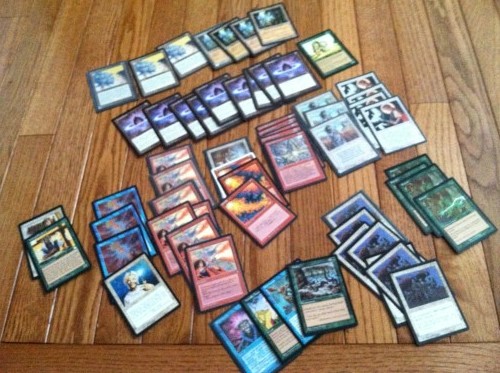
So… No Gaea’s Cradles. I went through hella magical spells + fantastic creatures; even found a mint-looking box stamed Urza’s Saga. There might be a Gaea’s Cradle in this house, but I didn’t find it.
Most of what I ended up setting aside this time around were black-bordered Legacy staples (i.e. Swords to Plowshares and Red Elemental Blast) and / or random cards that I have had to buy, play regularly, and / or keep misplacing right around when I need them (Nomads en-Kor including a foreign one, some Annuls, Pyroblast).
The “money” portion of this haul includes almost $100 in Lotus Petals including some foreigns, a set of Ancient Tombs, and a prerelease stamped Dirtcowl Wurm (though I have no idea if this is a $10 one or a $40 one).
But the ultimate inspiration of this post is that trio of Helm of Obedience up top; Helm of Obedience itself has become a one-of staple [again]. This is where being a convert comes in for me. Some of you know this story already but for those of you who don’t, once upon a time I was an idealistic blue mage. Not idealistic in the sense that I had stars in my eyes; rather I was one of those who felt that winning with creatures was somehow unsure or beneath a really skilled mage. I was the anti-me; idealistic to the point that how I won was more important than if I won. Me in 1995 or so would win only with Karma + Magical Hack or Ray of Erasure-fueled Millstone decks. I made my first tournament finals with an Orcish Spy + Millstone deck, though the judge at the time accused me of treating Orcish Spy as an enchantment; I ultimately lost to the first deck I faced that actually played Land Tax and / or Necropotence (i.e. could draw more than one card per turn).

What 1995 MichaelJ brought to the final table. Mondo combo!
I actually went through a point where I tried to buy every Helm of Obedience in my local market. I had a twofold objective here… I wanted to have ALL THE HELM OF OBEDIENCES so I could put them into all of my decks; and I didn’t want anyone else to have any (as all of my decks were woefully vulnerable to them). I gave up a at some point but remembering this, was fairly surprised to have only uncovered three today.
Now I played in a local Ice Age / Alliances Pro Tour Columbus warmup tournament in the summer of 1996, whichever one; finished in the elimination rounds and if memory serves, sniped Worth along the way. Back then Worth was the “local Pro” and the only person from our area who was actually qualified for PT3. I played a Circle of Protection: Green + Sleight of Mind U/W Control deck that killed with Helm of Obedience (usually via my opponent’s Deadly Insect). I had Thawing Glaciers all figured out early on, etc.
Fast forward some months later, to November of 1996, and I was prepping for my third-ever PTQ; which was Ice Age / Alliances format like PT Columbus. I was of course bragging left and right how I was going to take it down with my Helm of Obedience control deck. I lost. I lost and Lost and LOST and LOST. Middle of the night the night before that third-ever PTQ I soul gazed myself and asked the question that I think any successful Magician has to at some point face. Was I going to “stick to my guns” and play the deck I loved, that was “me” … Or was I going to alter my path, and with it alter my history in Magic?
I chose the latter.
24 hours later I had won my first-ever PTQ (actually finished Blue Envelope second to Erik Lauer), playing a B/R Necropotence deck.
So what’s the lesson?
Like I said, there is no zealot like the convert. I might harsh on green — my own play of green — because I did the math. I play[ed] green 80% of the time and lost consistently, versus playing non-green only 20% of the time and winning at a much better rate. I think my visceral reaction at a “pure” Control affinity by @affinityforblue is ultimately more about not liking the boy who bought all those Helm of Obediences… Less not liking anything about Joey. I like most everything about him.
Joey doesn’t care what wins the most; Joey cares about playing the game he wants to play, how he wants to play it. Bombastic as I can sometimes be, I have always been a big fan of learning from differing viewpoints; and like I said, if I were to big game Standard tomorrow, I’d be packing Joey’s Aetherlings.
Also I just wanted to gloat about finding 100 Gaea’s Cradles. I didn’t though; so you get Helm of Obedience.
LOVE
MIKE
P.S. You’ll note that I pulled 4-5 Guerilla Tactics (basically because I know Patrick Sullivan bought a play set prior to GP Denver and ruined Jund decks with them); next up I will recount the tale of Guerilla Tactics and my first Pro Tour.
June 25th, 2013 — Games, Magic
Yesterday I saw Garruk, Caller of Beasts spoiled on MTV.
I meant to write something at the time but I was distracted / delayed / apprehensive for a couple of reasons. Was this a real Planeswalker? A real Magic: The Gathering magical spell (that spits out DI fantastic creatures) or some kind of hoax? Was a well-meaning editor hoodwinked by a 5th Dimensional Imp? I mean it was on MTV. And in fact Tweeted about by an MTV Verified Account. Real? Real World?
Also I had to go to a dinner party.
Aside:
So in the last couple of months I have been feeling somewhat inordinately good about myself.
I wrote down a sort of foreseeable future not-bucket list in 2008 (a variation of a technique I wrote about in the last chapters of The Official Miser’s Guide actually). I liked this song The Hudson by my favorite songwriter; I wanted to live by the Hudson. Actually this is the view outside my new apartment:

I wanted to live by shenanigans. Pulling shenanigans. More shenanigans in the hopper. I wanted to eat better, work out more, spend more time with my family and play more Magic tournaments. I’m running close to a marathon a week; not at fighting weight yet but my resting heart rate is below 60. My kids are in love with me and I can’t remember a better time with my wife. I’m not back-to-back Legacy Open Top 8 grinder Chris Pikula or anything but I’ve played a nice run of Magic tournaments this year with several cash finishes.
So I have been [virtually] patting myself on the back. Yeah life! Yeah MichaelJ! I have been crossing off good stuff left and right off of my life-list. I have arr…
I have not arrived quite yet.
I walk into this apartment (which has its own elevator). It is one continuous hallway that is the city block long. You look out the window from one side and there is the Angelika theater. On the other side… Whatever is on the other block (I never made it that far actually, de-railed by the wall-installed temperature regulated wine rack and Next Level 3D art on the walls. An entire city block. The idea of this is just baffling to me; but I was there. The space was like nothing you have ever seen in a Manhattan apartment (there were rooms attached to the hallway on either side but I didn’t go into any of them).
Gotta sell lots of The Official Miser’s Guide still!
So anyway I go to this dinner party, come back for a short run, work on Top Decks, zzzzz eventually re-watching the season finale of Mad Men.
More distractions than your average iPhone.
So: Garruk, Caller of Beasts.
Well the alternate art is pretty cool I think you will agree!
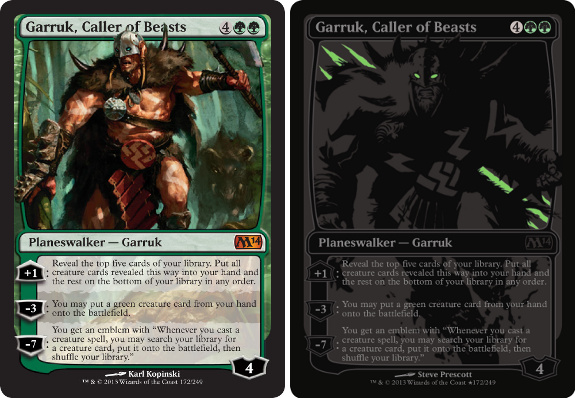
My impressions:
[+1] This will put Garruk to five and possibly out of range of the first swing in. Possibly. The card advantage is obviously potentially bonzer. Frank Karsten is 4-0’ing tournaments left and right playing nothing but creatures.
If you play nothing but creatures you might actually hit three cards on this (but then again you would probably have to re-work more than a little to accommodate the cost). A sub-Frank (but still reasonable) number of creatures for a Ramp deck — say 20 — is still going to net you 1-2 creatures on average. The down side is that a lot of times those creatures are going to be like Arbor Elf. At the point that you are rolling sixes I don’t know that this is what you want to be doing in a game under pressure. Then again there is probably nothing you would rather be doing in a grind situation. That said, I am not convinced this is all that much more powerful than either of the first two abilities on Garruk, Primal Hunter, especially given the extra mana investment; six over five being like ten over five under pressure.
Now speaking of the mana, six is a lot for a Planeswalker that may or may not be doing anything proactive on the battlefield. Six is in fact only one under Karn Liberated. Karn Liberated not only can directly and immediately affect the battlefield, but he is essentially the end game of an actual Modern deck. Cautiously optimistic on this one to start.
[-3] Now we’re talking!
I actually love this [-3] (leaving Garruk at 1 loyalty). You get to keep Garruk and you can use the ability to net mana. I am a big fan of tapping six to play Angel of Serenity* or Griselbrand** at a discount. Why think so small? In Modern you might be able to run Garruk, Caller of Beasts as a six mana redundancy on Primeval Titan and cheat out Emrakul, the Aeons Torn***. Could be a thing. Thanks Obama Lotus Cobra.
Taken another way Garruk, Caller of Beasts is only one more than Through the Breach but you don’t run out of it after one use. I am a buyer here, even if you don’t necessarily net mana. For instance I am not above playing Garruk, Caller of Beasts [back in Standard] to drop a Thragtusk (who can now double-defend Garruk). I can deploy multiple cards, not waste my mana, and use the [+1] to re-up the next turn. Like I said: Buyer.
[-7] Just want to throw it out there that I have played a lot of Garruk, Primal Hunter and have never in my life made Wurm tokens. Not even one time in the MTGO Tournament Practice Room. I think that if Garruk, Caller of Beasts starts calling up the beats it is going to be riding the incremental card and mana advantages from the first two abilities, not necessarily winning via the Ultimate.
Some interesting personal anecdotes about Planeswalker Ultimates:
- I have beaten Jace, the Mind Sculptor‘s ultimate in tournament play.
- I have beaten Domri Rade’s ultimate in MTGO play.
- I have both lost after activating Ajani Vengeant’s Ultimate and beaten Ajani Vengeant’s Ultimate in MTGO play.
- I have not only lost after activating Liliana of the Dark Realms‘s Ultimate, I have had enough loyalty to activate it more than once and still lost in both Grand Prix [paper] and MTGO play.
- I have tried really, really hard to beat Tamiyo, the Moon Sage’s Ultimate through means various; but apparently infinite card advantage > cleverness.
Going to go out on a limb and say I am unlikely to activate Garruk, Caller of Beasts’s Ultimate in paper.
LOVE
MIKE
* EDIT: Can’t do that.
** Or that.
*** Or that, either! “Green” — my archenemy. It is known Khaleesi. Imagine I got it right the first time and said “Progenitus” or something. Obviously missing that particular chromatic adjective lowers my rating of this a bit will have to think on it more. What is there awesome in Standard for 7+? Can’t see Sylvan Primordial being good enough.
February 2nd, 2013 — Games, Magic
So would you have made this play?
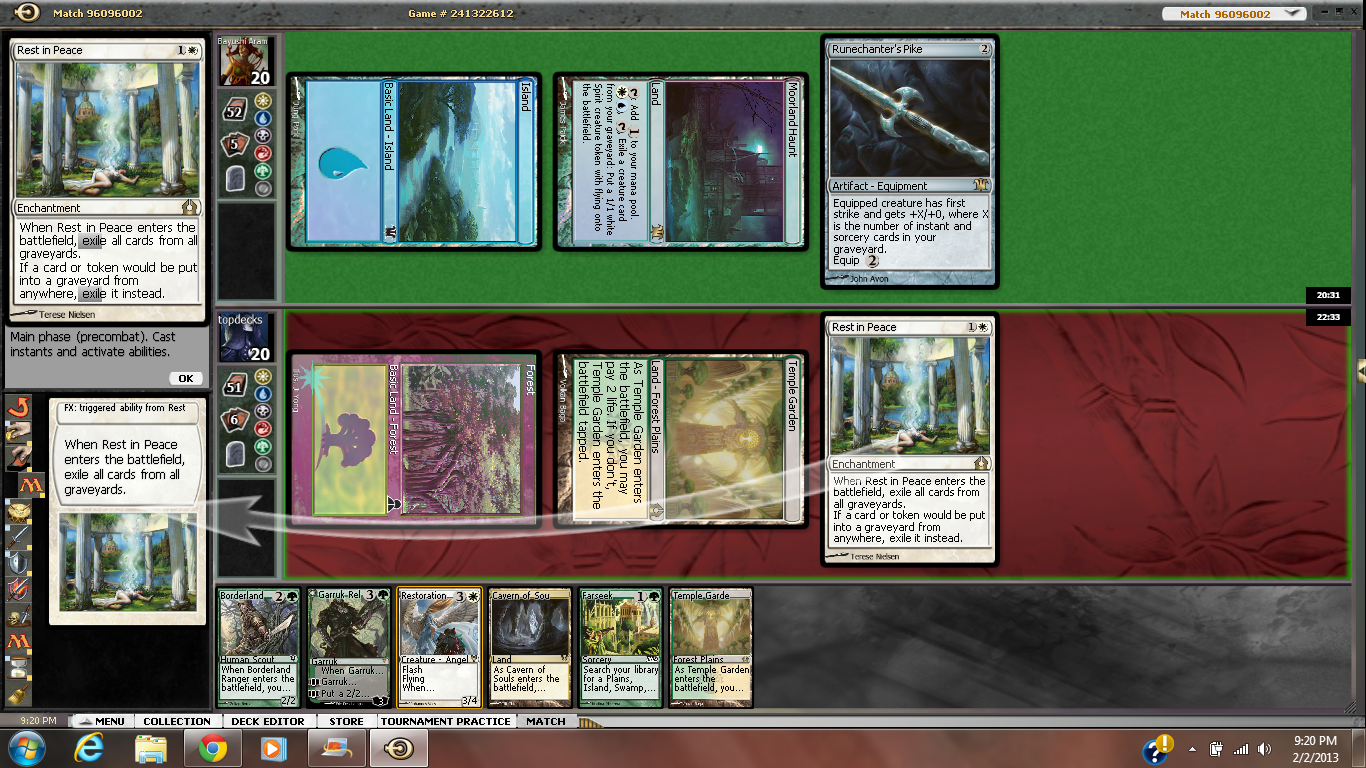
Standard operating procedure for this kind of deck would obviously be Farseek (chain into Garruk Relentless with a Borderland Ranger + Rest in Peace follow-up, possibly via Cavern of Souls)… But I couldn’t resist the sweet, sweet justice of Rest in Peace against Moorland Haunt + Runechanter’s Pike on the second.
Very likely I am going to play a G/W-based Selesnya Ramp deck a la Caleb Durward at next week’s Standard Open in Edison, NJ… But Caleb says there is no reason not to play a third color… Figure I go with this guy girl fish:
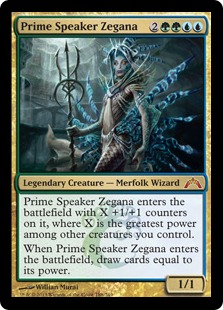
Prime Speaker Zegana is a perfect follow-up to Thragtusk, a la Garruk, Primal Hunter… But potentially even more powerful. Also sweet with a Restoration Angel!
So… Would you have run out the Rest in Peace or played the usual Farseek? BTW easy 2-0 is easy.
LOVE
MIKE
January 9th, 2013 — Magic, Uncategorized
Earlier this week my old Apprentice Will Price aka WillPop aka SloppyStack lobbed this tweet at YT:
This is the Gatecrash card to which beloved WillPop was referring:
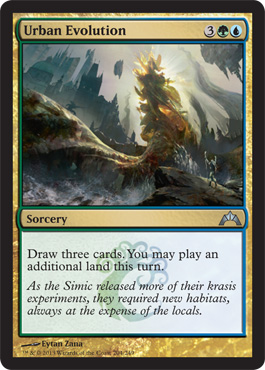
I must admit my snap judgment on the card is favorable. Is it really “bad” of me though? I thought I’d compare Urban Evolution to some other cards and think about how it stacks up.
Jace’s Ingenuity
When Jace’s Ingenuity first came out, I called it overrated. My system doesn’t really care if you are an instant or a sorcery in terms of CMC, and Jace’s Ingenuity was therefore just one more than Concentrate. Of course the first time I played Jace’s Ingenuity I ended up spiking a $5K. Jace’s Ingenuity was great!
Now had Jace’s Ingenuity been Concentrate, it probably wouldn’t have single-handedly crushed my combo-Exarch Twin opponent, so perhaps I was wrong on my orignal assessment of that card. From a pure effect standpoint, Urban Evolution is more effective than Jace’s Ingenuity. You get to draw the same three cards, but seeing as you will often draw an incremental land, you get a solid option tacked on. Of course, if you don’t draw another land (but you already had one), Urban Evolution is still fine with that.
Tidings
Three cards against four. Four is bigger than three… But putting a permanent mana source into play is worth something. Lay of the Land and Rampant Growth have both been playable cards, and there is a reason that the extra mana is justifiable on a Rampant Growth.
One mana is about the value of a card… The two cards are therefore relatively equal in power.
Cosmetically, the first difference we see is 3UU versus 3GU; 3GU = 1G + 2U. Urban Evolution is actually exactly Explore + Counsel of the Soratami. Explore and Counsel of the Soratami (or Divination) are both / all playable cards. Putting them together like this, compacting multiple reasonable effects into a single card, actually increases its economy.
Strong.
My guess is that the Explore-ness of Urban Evolution will be an incidental source of additional utility, rather than being particularly strategic to a deck’s focus. I do think it is a potentially strong basket of effects, so the real question is where Urban Evolution might see play.
Urban Evolution just seems like a better card than Amass the Components to me. The sole known Amass the Components deck already plays Farseek… The existing Bant shell can certainly accomodate Urban Evolution already.
It is probably also the kind of card we might see in a potential Enter the Infinite deck. Such a deck would have a strong interest in not just digging to Omniscience but to have lands in play to cast it. Again, I can see some hand-in-hand there.
Bad habits? I don’t know.
But sure, I’ll buy that R&D is doing all kinds of stuff to tug at ye olde heartstrings.
LOVE
MIKE
January 7th, 2013 — Magic
Last week I wanted to give my friend Patrick Sullivan’s RDW strategy in Legacy a whirl. I made my deck with main-deck Searing Blaze, as Patrick had suggested when I hung out with him in Las Vegas recently.
Testing was brief and miserable.
It wasn’t Patrick’s fault.
I was playing two-man Legacy queues on MTGO and — as is sometimes the case in the wee hours — you keep trying to get reps in on a two-man queue, and you just end up playing the same guy over and over. In this case, the guy was playing a Show and Tell / Omniscience deck. He got very fast draws and beat me badly a couple of times. I made a mental note that if I were to try Patrick’s deck in a real / big Legacy tournament (like the upcoming Star City Invitational in NJ in a couple of months) I would play Red Elemental Blast or thereabouts. I didn’t like having no access to meaningful interaction.
The first time we fought I sided in Ensnaring Bridge. I even drew one for his turn two or turn three Show and Tell! The opponent had beaten me in Game One with Emrakul, the Aeons Torn. I decided that even if he was “legitimately” casting Emrakul (i.e. getting the free Time Walk) that I could keep him from actually attacking me.
Unfortunately instead of Emrakul, he dropped Omniscience; his next play — upon seeing my Ensnaring Bridge — was to play a free Burning Wish. He found the seldom-seen Petals of Insight and drew through his deck until he could find a non-attacking way to win. He ended up just racking up tons of reps with his Petals of Insight (all free, thanks to Omniscience), found another Burning Wish, played it (for free) and got a Grapeshot (again for free, and more than big enough to kill me).
Like I said, I dropped out of the Legacy queues and eventually worked on my Liliana of the Dark Realms deck, which turned out brilliantly, as you know. I stopped playing Legacy RDW (at least for a little while) but really admired the ingenuity of including a card like Petals of Insight, really taking advantage of the radically altered game state afforded by an on-line Omniscience.
Luckily, this is a reality limited to big formats.
Or is it?
Enter, ahem, Enter the Infinite:

Enter the Infinite
Travis Woo has recently returned to the forefront of rogue deck design with his OmniDoor deck. A Standard Omniscience deck, Travis’s plays Omniscience and then sets up a couple of copies of Temporal Mastery. It can win all different ways including getting in multiple shots from Nicol Bolas, Planeswalker (with two extra turns it isn’t hard to get Bolas Ultimate) or just attacking you with a Thragtusk powered up by Kessig Wolf Run.
With Enter the Infinite, once you have Omniscience down, you can just draw your deck and win with whatever you want to win with. You kind of really do need Omniscience first, because even if you can cast Enter the Infinite to draw your deck, that doesn’t mean you can cast everything. “All your cards” doesn’t equal “all necessary mana” … But when you have Omniscience down that’s not a problem.
My current favorite way to close out an “infinite” game is by getting all the copies of another new card, Biovisionary:
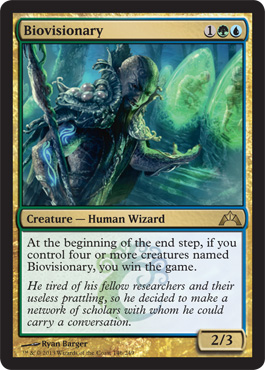
Biovisionary
Obviously you can just get all four and put them into play; or you can get all four, Clone and Evil Twin them, and then pass. Interacting with you at this point is probably pointless, because you can have a Counterspell (and the “mana” to use it). You probably have access to more good answers in hand (and can cast them) than the opponent has spells, total.
BDM mentioned tonight you can get circa one Laboratory Maniac [as well] and win with card draw if something happens to your Biovisionaries.
But hey!
Just spitballing.
Not much else matters when you Enter the Infinite, after all.
LOVE
MIKE
January 5th, 2013 — Magic
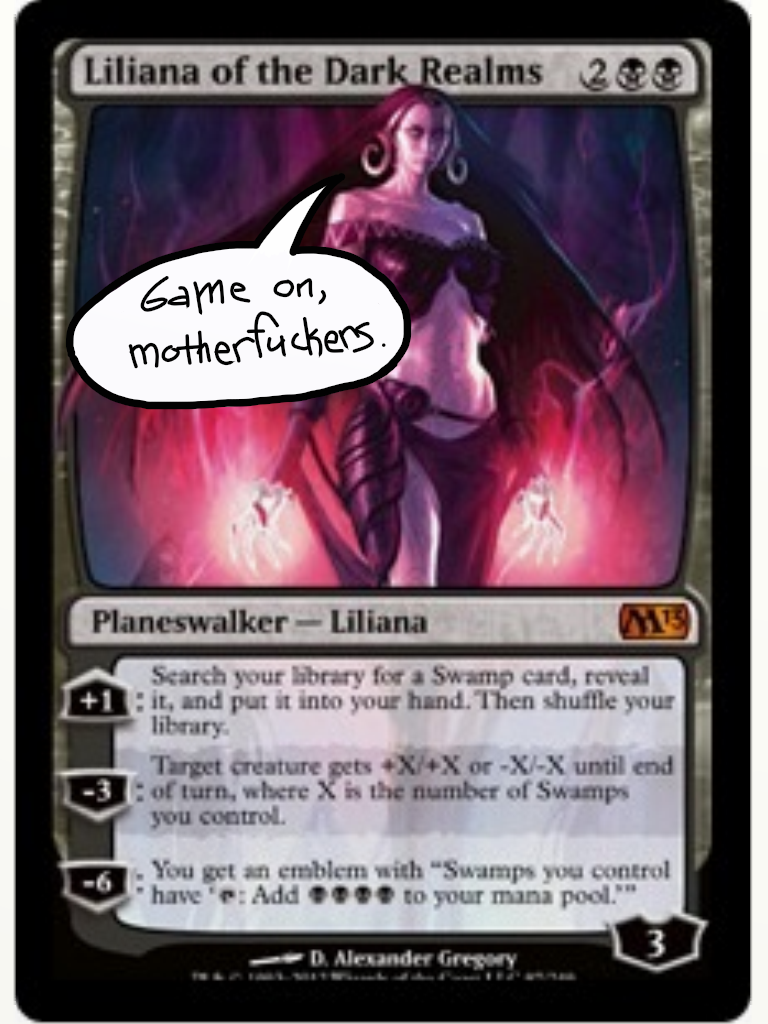
A few months ago then-R&D member Zac Hill previewed Liliana of the Dark Realms over on ye olde Mother Ship. Today Zac is in NYC, so we chat, have had a coffee, etc. One thing that has come up between us is the general under-appreciation of Liliana of the Dark Realms by the Magic community at large.
Probs they’ve just never played with her.
Liliana of the Dark Realms is an unambiguously powerful Magic card. For close to twenty years man has yearned for nothing more than a one-way Howling Mine. If nothing else, Liliana is that; she’s really good at her job. Black control decks are often mana hungry. Liliana helps make sure you hit your fifth land drop (or fourth, with a Rakdos Keyrune), and is generally big enough to get a second [+1] activation. I can’t say I use Liliana of the Dark Realms to kill a lot of creatures (maybe one murdering out of three matches), but especially in Game One situations (when you don’t have Rakdos’s Return in your deck) she goes baby Ultimate by giving Vampire Nighthawk +10/+10 or thereabouts.
Oh, and game on?
I just hit submit over at the home of The Official Miser’s Guide.

“Click to make me big.”
So it looks like I’m pretty pot committed to Liliana of the Dark Realms at next weekend’s Grand Prix Atlantic City.
Thanks to Liliana of the Dark Realms for drawing me so many extra cards.
And thanks to Zac for reminding me that Liliana of the Dark Realms draws so many extra cards 🙂
More on this next Flores Friday (probs).
LOVE
MIKE
December 10th, 2012 — Everywhere, Magic, Writing

One of the most compelling voices in the Magic community, Patrick Chapin “The Innovator” is a member of the Magic Pro Tour Hall of Fame and the author of Next Level Magic.
Warning:
This article contains profanity, including gay and racial slurs.
“Don’t be a faggot.â€
When we communicate, it is not just some trivial exercise. It is not about repeating words in familiar patterns, like a machine.
Real communication is about conveying meaning.
I generally don’t use the word “nigga†(or its various analogues)—not because it is taboo, but because it tends to obscure meaning, rather than convey it.
I spent a number of years in prison. During my time there, I dwelt in an awful lot of circles that used the term very freely. In public settings, it would have been inappropriate to use this language. However, it is a term that has taken on many ironic reversals and additional meanings over the past thirty years, and when it was just me and people I knew, it was generally acceptable for Caucasians, such as myself, to use the term and be referred to by this term.
However, just because the group had accepted this language doesn’t mean it promoted healthy thought patterns. If I can say it another way, a way that is clearer and contains more real meaning, why would I cling to a word that can cause misunderstanding and confusion?
“Don’t be a faggot.”
We can go on about how that word doesn’t mean what it used to, so people shouldn’t be offended by it, but in the real world, that hurts people, particularly ourselves. It influences how we think, and not necessarily for the better.
Words mean things.
Many boys grow up in environments where they are pushed around or otherwise made to feel inferior. Sometimes they are bullied. Often, fathers, brothers, or other older boys will assert themselves as “the dominant males” over the younger ones.
These older males provide the models that the younger ones use to formulate their worldviews and their strategies for interacting in life. If a boy’s role models use bullying and abusive behavior to try to control the people around them, this provides a blueprint for the boy to follow, often long before they are even aware of it.
The Magic community contains quite a few adolescent boys. A common phenomenon in adolescent boy cultures is the use of rape slang, which reveals a lot about the nature of rape.
Rape is about power.
Some men treat or see other people, usually women, as objects rather than as human beings: trophies to be fought over and won; dogs to be commanded and punished for misbehaving. At its core, rape is about power over an individual, making someone submit to one’s will and transforming that person into an object or an obedient animal.
Part of it is an attempt to release anger and frustration, but the release is only temporary. Because of this, the rape mentality generally leads to repeated behavior.
What does this have to do with using the word “rape†as slang for “won by a large margin?â€
When someone uses the expression, “He got raped,” they are generally just repeating something they’ve heard someone else say. After all, if you or a loved one has been raped, the expression is a lot less funny.
“He got raped.â€
I used to do commentary for the Top 8 of Pro Tours sometimes, way back about ten years ago. Back then, there was a rotating cast that included Chris Pikula, Brian Weissman, Brian Hacker, Brian Kibler, Randy Buehler, Michael Flores, Matt Place, myself, and more.
During the Top 8 of a Pro Tour, I was in the booth, in a role not unlike the one I adopt from time to time for SCG Opens. Between rounds, a WotC employee pulled me aside and asked me to watch my language. I was taken aback. What had I said? I wasn’t swearing.
“It’s not cool to describe one player as raping the other.â€
I hadn’t even been thinking and obviously didn’t mean anything by it, but here I was, a dumb kid who didn’t know anything about anything, and I was using rape slang in the official WotC commentary.
Now here is the part that makes me look back and cringe.
My response was to try to explain to this person—who was only representing the interests of a company that sells games to people of all ages—that “rape†doesn’t always mean forcing someone to have sex. It is also “slang†for beating someone badly.
It’s amazing how much you know when you are 18.
“Words mean things. If that is how you talk when you are with your kid friends, that is your business, but if you want to interact with the adults, you are going to have to face the reality that words mean things. You aren’t talking to hear yourself speak. Whenever you talk, whoever can hear you is your audience. Remember what it is you are doing.â€
I felt like an idiot. Despite knowing everything (I was 18, so kind of a given), I realized that just as chronic swearing is a symptom of a shortage of intelligence, so too is the inability to adjust one’s language to the situation at hand. Looking back, I didn’t even consider at the time just how inappropriate that kind of language was in an official capacity, let alone in any kind of public forum.
However, it is not just being mindful of the language we use in public. The language we use behind closed doors influences our thought process.
“Don’t be a faggot.â€
The expression is said to have nothing to do with sexuality, a way of saying, “That’s not cool.â€
At its core, this expression means “Homosexuality is so not cool, the most powerful way I can condemn your action is by suggesting that it is as bad as being homosexual.†That may not be one’s conscious thought process, but that is what they are saying.
The use of “faggot†as a derogatory term stems from hateful origins towards both women and homosexual men. Eventually this led to its popularity as a term boys say to each other in an attempt to assert their own masculinity by challenging the masculinity of other boys (following the example of those around them). In this context, “faggot†is not a permanent identity, such as one’s ethnicity or name. Rather, it is fluid, an identity that one seeks to avoid, such as being “it†in a game of tag. Many boys play this game of tag for years, back and forth with other boys.
“You are a fag!â€
“No, you are!”
That’s adorable, but words mean things. If that is how you talk when you are with your kid friends, that is your business, but if you want to interact with the adults, you are going to have to face the reality that words mean things. You aren’t talking to hear yourself speak. Whenever you talk, whoever can hear you is your audience. Remember what it is you are doing.
When we are at a Magic tournament, we are confronted with a whole lot of people, many of whom we don’t know all that well. It can be very tempting to try to assert our masculinity by challenging the masculinity of others.
Want to know a secret?
If you are actually secure in your masculinity, you have no need for such petty tools.
What’s more, use of this language speaks volumes about a person, and the people around them pick up on the message between the lines.
Do you think Brian Kibler uses those words? What about Luis Scott-Vargas?
The words we use shape who we are. They influence our thought patterns and steer how we approach things.
The reasons to avoid such language in public settings, such as a Magic tournament or Facebook, are obvious. After all, when you are talking, everyone who can hear you is your audience. We did not come to this game accidentally. We are intelligent. We have more effective ways of communicating.
However, reconsidering hateful speech publically is only part of the equation. It’s not about the word itself; it is about the thought process. This thought process is toxic, and if you indulge in it in private, it will influence you in public.
You know why rape and hate slang continues? The same reason all slang does — because of people repeating it. From experience, I can tell you, it is relatively easy to clean up a circle’s language. If you resolve that something isn’t cool, it doesn’t take long for it to impact the circles you run in. That circle reflects who you are but also leaves impressions on you. If you do not impress on it, it will impress on you.
I am blessed with a number of close gay friends who have greatly enriched my life. Each of my experiences leads me to believe that potentially shutting out a percentage of people from my life by using hateful language is a huge mistake.
We all have our own path to walk.
There is room for an awful lot of people to live lives that are not identical to our own. What is right for someone else is not necessarily right for us, and what is right for us is not necessarily right for them. Why not give them the benefit of the doubt, especially if they are not hurting someone else?
No matter how tempting to try, we can’t make everyone else do what we want. What we can do is decide who we are, right now. It might not be the same as who we were yesterday, and that is okay.
When we see someone making fun of someone else at a Magic tournament for being different, we have lots of options. Are we someone who joins in, attempting to assert our masculinity? Are we someone who just tries to fit in with the crowd? Are we someone willing to stand up for someone who is outnumbered? Are we someone who is just afraid to say something, fearing becoming the next target? Are we someone who believes it is wrong to treat someone badly because of their race, sexuality, or gender?
Obviously none of this is to say that censorship is the answer. Words mean things, and if a given word is what you really want to say, more power to you. Rather, I’m trying to dispel the naïve notion that just because you might not be offended by a word, it doesn’t mean it’s not harmful and needless. Look, I am always touched when a straight, white American male is not offended by something, but maybe we are forgetting what it is we are doing.
There is a real temptation to defend slurs by arguing that the burden is on the other person to not be offended. After all, can’t anyone just say they are offended by anything? The thing is, asking someone if they are offended by something isn’t particularly fruitful. You don’t think it just puts all the pressure on them and risk being hated more? Likewise, a single person saying they are offended by something doesn’t make it offensive. It is a piece of evidence that helps build a case, but declaring something offensive does mean other people are offended by it.
Using slurs is harmful, not just because of the possibility of offending someone. It is harmful because of the implications. It makes people uncomfortable; it’s disrespectful; it’s bullying; and sadly, it leads to influencing the victims to go out and find victims of their own.
Words mean things.
Whenever people do something differently, someone is going to lash out against them. Maybe they’ll laugh at them, ridicule them, or hate them. People are scared of change, and they fear what is different from them.
Recently, I heard a young man, who considers racism obviously stupid, verbally attack a transgender individual he had never met.
“Faggot.â€
What had this individual done to earn scathing slurs in front of countless people?
They had succeeded at something the boy wished he could succeed at.
Here we have a boy who considers himself a moral authority, who realizes the foolishness of racism; and yet when confronted with someone different from him, he didn’t even realize what he was doing.
Just as any woman who Top 8s a major event is greeted by some percentage of boys who hurl degrading remarks about her gender, someone transgender and successful is greeted with hateful slurs. Why?
It’s hard enough to live a transgender life. What do we gain by making their life harder, more painful? You don’t have to agree with all of someone’s choices or even understand them. However, if they aren’t hurting someone else, why attack them? Why be cruel?
In my experience, an awful lot of young men playing Magic have had some experience with racism. They’ve come to realize that it is not useful and not who they are; not as many Magic players have interacted with transgender individuals, so perhaps looking to broaden our perspective is worthwhile.
Imagine what it is like, everyone telling you that you are wrong about who and what you are. It can be a pretty tough spot to be. Imagine a bunch of people telling you what you should or should not be, say, or feel, but at the end of the day, it doesn’t necessarily reflect what’s going on inside of you.
Being transgender can be like that.
You may disagree with the actions someone is taking, and it may not be something that meshes with your worldview, but are they are hurting anybody? There is no question the life they are living is potentially fraught with hardships and pain, and you are certainly not obligated to do anyone any favors. However, do you really need to torment them and make their life harder? What does that accomplish?
Maybe they will eventually evolve their views. Maybe you will eventually evolve yours. Still, if neither of you changes your views, so what? No one needs to be hurt.
Picking on people in a position of weakness (such as being different from everyone else and having to deal with a world that is not built for them) is an act of cowardice. Whether using slurs because of anger or hate or using them out of ignorance of the implications of slang that carries with it pain and negativity, you have the choice to decide for yourself if that is who you are, or if you are better than that.
You also have the choice to act when you see someone else repeating this noise, without even thinking. I know I am so thankful for that individual who talked some sense into me all those years ago. People may push back, as confronting the truth can be scary, but they may thank you someday.
The signals you send to the world dictate what the world brings you. Make a statement to the world that you are full of kindness, courage, or love, and the world will bring you experiences to match. Make a statement that you are a coward, insecure, or full of hate, and the world will bring you experiences to match.
You want to win more at Magic?
You want to succeed more at anything you do in life?
Be strong. Be open-minded. Be courageous. Be a force for positivity. Be the greatest version of yourself you can envision.
Patrick Chapin
“The Innovatorâ€



















